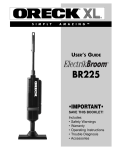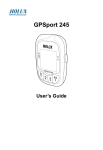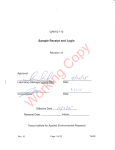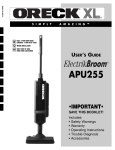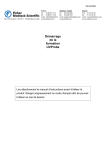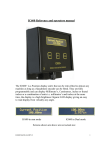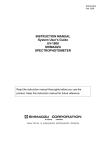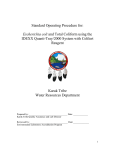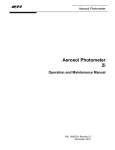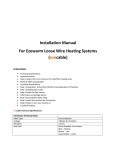Download Operation and Calibration of the UV-Vis - TIAER
Transcript
QAM-l-103
ki
ng
C
op
y
Operation and Calibration of the
UV-VIS S pectroph otometer
or
Revision 8
W
Laboratory Manager/
Laboratory Quality Assurance Officer
t lqlr
Date
2
-v
-){
Date
Errectivedate:
Renewal date:
zfqftf
lnitials:
Texas lnstitute for Applied Environmental Research
QAM-I-103
Operation and Calibration of the UV-VIS Spectrophotometer
1. Applicability
This procedure applies to the operation and calibration of the Beckman
Coulter DU-640 UV-VIS and Shimadzu UV-2450 (manual mode)
spectrophotometers located in the chemistry laboratory of the Texas
Institute for Applied Environmental Research (TIAER), Tarleton State
University, Stephenville, TX. This procedure shall be performed prior to
any analysis using one of the spectrophotometers
ng
C
op
y
2. Purpose
The purpose of this procedure is to provide a method for operation and
calibration of the DU-640 and UV-2450 spectrophotometers. By
utilizing appropriate chemisty SOPs to perform the standard calibration
for each set of samples, the analyst eradicates anomalies due to
reagent mixture variations, sample preparation variations, and
instrument sensitivity fluctuations. The operation of the instrument
allows the analyst to determine the concentration of various chemical
species which are dissolved in water samples or extracts analyzed by
the TIAER chemistry laboratory.
W
or
ki
3. Definitions
3.1. Automated Sipping Device- A device used in conjunction with the
instrument serving as a sample container-to-photometric cell sample
delivery conduit.
4. Equipment, Reagents, and Standards
4.1. Equipment
4.1.1. Beckman Coulter DU-640 spectrophotometer
4.1.2. Shimadzu UV-2450 spectrophotometer
4.1.3. 10-mm square sided silica or quartz cuvette (for uv region) or 10mm square sided glass or plastic cuvette (for the visible
wavelength region); may be flow-through or manual pour cells
4.1.4. 100-mm tubular cuvette, or other sizes
4.1.5. Cuvette holder (adapted for size of cuvette)
4.1.6. Automated sipping device or autosampler (if applicable)
Rev. 8
Page 2 of 8
TIAER
QAM-I-103
Operation and Calibration of the UV-VIS Spectrophotometer
ki
ng
C
op
y
4.1.7. Sample tubes or other glassware appropriately sized to serve as
mixture vessels for water samples or extracts and reagents
4.1.8. Autosampler boats
4.2. Reagents
4.2.1. Deionized Water (DI)
4.2.2. Color reagent solutions- contain all color or complexing reagents,
sample solvents, and other chemical species which will be added
to the samples prior to analysis by the uv-vis instrument. Refer
to the appropriate chemical SOP for specific solutions and uses.
Non-color reagents are also used in organic extractions and
sample preparation.
4.2.3. Cleaning solution for automated sipper and cell- add 5 drops
Triton-X 100™ and 5g NaOH to 500 mL DI H20 and dissolve.
4.3. Standards
4.3.1. The standards required for the analysis of samples are
determined by the analyte. Prior to performing any analytical
procedure using the uv-vis spectrophotometer, the standard
operating procedure for chemical analysis are reviewed to
determine all of the required parameters and standards.
W
or
5. Procedure
5.1. Beckman Coulter DU-640 (primarily for determination of OPO4P and
as a backup to the other instruments)
5.1.1. Powering Up
5.1.1.1. The instrument may be turned off overnight.
5.1.1.2. Turn on the instrument with the power switch located on
the right-hand side of the back of the instrument. The
display should illuminate, and a message window with
“Executing Power Up Diagnostics” should be displayed.
5.1.1.3. In a few minutes a table indicating the Power Up
Diagnostics will be displayed. The table should indicate
that the parameters “RAM Option” and “Programmability”
are “Not Installed” and that “RS232 Ports 3 and 4” is
“Installed.” The word “Passed” should be indicated for all
other parameters.
Rev. 8
Page 3 of 8
TIAER
QAM-I-103
Operation and Calibration of the UV-VIS Spectrophotometer
W
or
ki
ng
C
op
y
5.1.1.4. If any parameter fails, flush the flow cell with cleaning
solution and DI water and turn the instrument off. Repeat
power-up steps. Consult manual for troubleshooting, if
necessary. Continue when the instrument successfully
completes power up diagnostics.
5.1.1.5. Move the cursor arrow to the upper right hand corner of
the Power Up Diagnostics table to the word quit and click
on it to exit.
5.1.2. Calibration
5.1.2.1. Turn on the appropriate source by clicking on the [VIS
OFF] or [UV OFF] on the menu bar. The icon selected
should turn red and change to [VIS ON] or [UV ON] to
indicate that the source is on.
5.1.2.2. Allow the instrument and source to warm up and stabilize
for approximately 30 minutes.
5.1.2.3. Select the “Fixed Wavelength” mode.
5.1.2.4. Prepare a calibration blank with DI water or extracting
solution and all reagents that will be used in the samples
according to the proper procedure.
5.1.2.5. The instrument should be in absorbance mode. Mode
can be changed by clicking the icon next to the word
“mode.” Clicking will toggle the instrument between
absorbance “Abs” and percent transmittance “%T”.
5.1.2.6. Click on the field to the right of the “λ” and input the
proper wavelength for the analyte being tested.
5.1.2.7. Draw the blank into the flow cell by inserting the sipper
tube into the culture tube and pressing the fill button on
the pump.
5.1.2.8. Click on the “blank” icon on the menu bar. When the
“Reading Blank” box disappears the instrument is
calibrated and ready for use.
5.1.3. Pre-operation Checks
5.1.3.1. Prior to performing any analytical operations, the analyst
verifies proper connection between the instrument and all
output devices.
Rev. 8
Page 4 of 8
TIAER
QAM-I-103
Operation and Calibration of the UV-VIS Spectrophotometer
W
or
ki
ng
C
op
y
5.1.3.2. If the system is connected to an automatic sipping device,
check the connections between the device and the
instrument also.
5.1.3.3. Once all connections have been checked, sample
analysis is ready to be performed.
5.1.4. Operation
5.1.4.1. Power up instrument as described above.
5.1.4.2. Calibrate the instrument as described above.
5.1.4.3. Click on the field to the right of the “Factor” and input the
proper factor.
5.1.4.4. Using the proper vials as reaction containers, prepare the
samples and standards as indicated in the standard
operating procedure for the chemical analysis.
5.1.4.5. Normally the analytical order is set by placing a blank
solution in the first slot, then following with the standards,
samples and quality control aliquots, which include
duplicates and spikes.
5.1.4.6. Use the complete set of standards listed in the standard
operating procedure for chemical analysis immediately
after the blank.
5.1.4.7. An initial calibration verification and initial blank
verification should be performed at the beginning of an
analytical run and a continuing calibration verification and
continuing calibration blank check are placed at the end
of each QC batch. Other verification such as laboratory
control standards or limit of quantification standards may
be used if required by project.
5.1.4.8. Load the sample boat onto the auto-sampling device.
5.1.4.9. Click on the “Read Samples” icon to begin analysis and
allow the instrument and auto-sampler to complete the
run.
5.1.4.10. When the run is complete open the “1. Get Data” icon on
the auxillary computer. This will bring up a box, click the
“activate” button. Open the “SAVECLEAR” icon on the
instrument screen. Change the file name to “DATA” and
Rev. 8
Page 5 of 8
TIAER
QAM-I-103
Operation and Calibration of the UV-VIS Spectrophotometer
W
or
ki
ng
C
op
y
click “O.K.” Choose “O.K.” and overwrite both files. Exit
the box on the auxillary computer. All further steps will be
with the auxillary computer only.
5.1.4.11. Open the “2. Change Data” icon. Open the file “data.duf”
or “data” file. Change the data to Excel format and save
as “data.” The old file will be written over.
5.1.4.12. Open the “3. Data” icon and type in standard designations
and sample #s in Sample ID column. Print the file and
affix to the Personal Logbook.
5.1.4.13. If desired, automatically transfer the data file to ESDMS
or data management system.
5.1.4.14. Data may also be entered manually into ESDMS system.
5.1.4.15. Flush ethanol through the system, followed by DI. Other
cleaning solutions may be used on occasion. Refer to
specific SOP for instructions.
5.1.4.16. If finished, turn off the light source and clean area.
5.2. Shimadzu UV-2450- Manual only, no autosampler used at this time
(primarily used for chlorophyll and pheophytin analyses, low level
orthophosphate P and NO3N and as a backup to the DU-640)
5.2.1. Power up the instrument and the computer.
5.2.2. Start the UVProbe 2.33 software from the computer icon.
5.2.3. Install the correct cell holder for the application (refer to
analytical SOP for details). Leave the cell slot blank.
5.2.4. Ensure that the “Photometric” view is open, then click “Connect”
to establish the link between computer and instrument. This
may take several minutes.
5.2.5. If connection window shows errors, troubleshoot according to
the User’s Manual. Problems may include power not being on,
blocked light path or light source not working.
5.2.6. Once all test have passed and a connection is established, click
“OK”.
5.2.7. Click the “λ Go to WL” and enter the wavelength desired.
5.2.8. Fill the required cell with blank reagent or reacted blank. Use a
Kimwipe to gently wipe down the cell light path and hold up to
look through at light. Ensure no droplets or smudges are
Rev. 8
Page 6 of 8
TIAER
QAM-I-103
Operation and Calibration of the UV-VIS Spectrophotometer
C
op
y
present. Wipe until clean. DI water or ethanol may be needed
to clean the cell ends.
5.2.9. Place the cell in the holder and click “Auto Zero”. Repeat for
each wavelength used per analytical SOP.
5.2.10. The program takes continuous readings for subsequent
measurements of samples and standards in the cell. Allow the
reading to stablize to 3 decimal places and take the best
reading for the 4th.
5.2.11. Power off instrument and computer when complete and clean
up cell and work area.
5.2.12. Other developmental methods such as multiwavelength scans
and timed reading may be performed for informational studies
and research. Consult the User’s Manual for these operations.
Included herein is only the simple, manual operation of the
instrument.
W
or
ki
ng
6. Quality Control and Safety Aspects
6.1. All aspects of this procedure shall comply with QAM -Q-101,
"Laboratory Quality Control", and QAM-S-101, "Laboratory Safety".
6.2. Quality Control
6.2.1. The analyst always uses matched cuvettes, if using more that
one cuvette, when performing analysis with the uv-vis
spectrophotometer. This ensures the pathlength parameters
will be equivalent and the measurements are accurate and
reproducible.
6.2.2. The preparation of all samples, standards, and blanks are
carried out using identical methods and preparatory equipment.
This eliminates the majority of errors which may be introduced
during sample solution preparation.
6.2.3. The auto-sampler, cuvettes, and all associated equipment are
cleaned and rinsed thoroughly with DI water prior to and
following use. Other cleaning solutions may be required on
occasion at the direction of the Laboratory Manager.
Rev. 8
Page 7 of 8
TIAER
QAM-I-103
Operation and Calibration of the UV-VIS Spectrophotometer
ng
C
op
y
6.2.4. All instrument maintenance performed on the
spectrophotometer are documented in the Maintenance
Logbook, QAM-Q-103-1.
6.2.5. Any major modification or parts replacements initiates a new
Demonstration of Performance in accordance with QAM-Q-101,
“Laboratory Quality Control”, to ensure the instrument is
functioning properly prior to data generation.
6.2.6. The DU-640 retains calibration factors and only needs to be recalibrated at the direction of the Laboratory Manager.
Calibration information is kept with each analytical run record.
6.3. Safety
6.3.1. The solvents or complexing reagents which are used during
analysis of water samples or extracts may be toxic or acidic.
The analyst always consults the MSDS files if he or she has
any question as to the safe handling of any reagent required by
the standard operating procedure for chemical analysis.
W
or
ki
7. References
7.1. DU® SERIES 600 SPECROPHOTOMETER, OPERATING INSTRUCTIONS,
MANUAL, Bec kman Instruments, Inc, 1992, Fullerton, CA, Manual 514531B.
7.2. User’s Manual, UV-2450, Shimadzu Corporation, 2008, Kyoto, Japan.
7.3. National Environmental Laboratory Accreditation Conference (NELAC)
standards, TNI, 2009.
7.4. TIAER Quality Assurance Manual, QAM-Q-100, latest revision.
8. Attachments
None
Rev. 8
Page 8 of 8
TIAER








